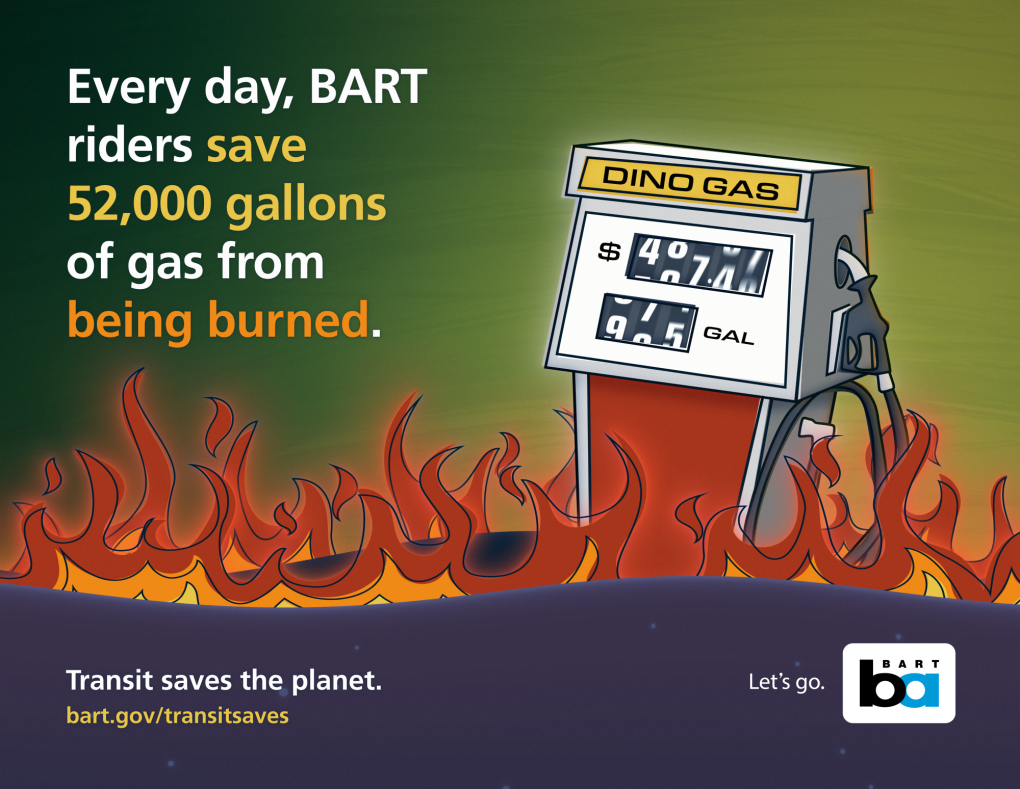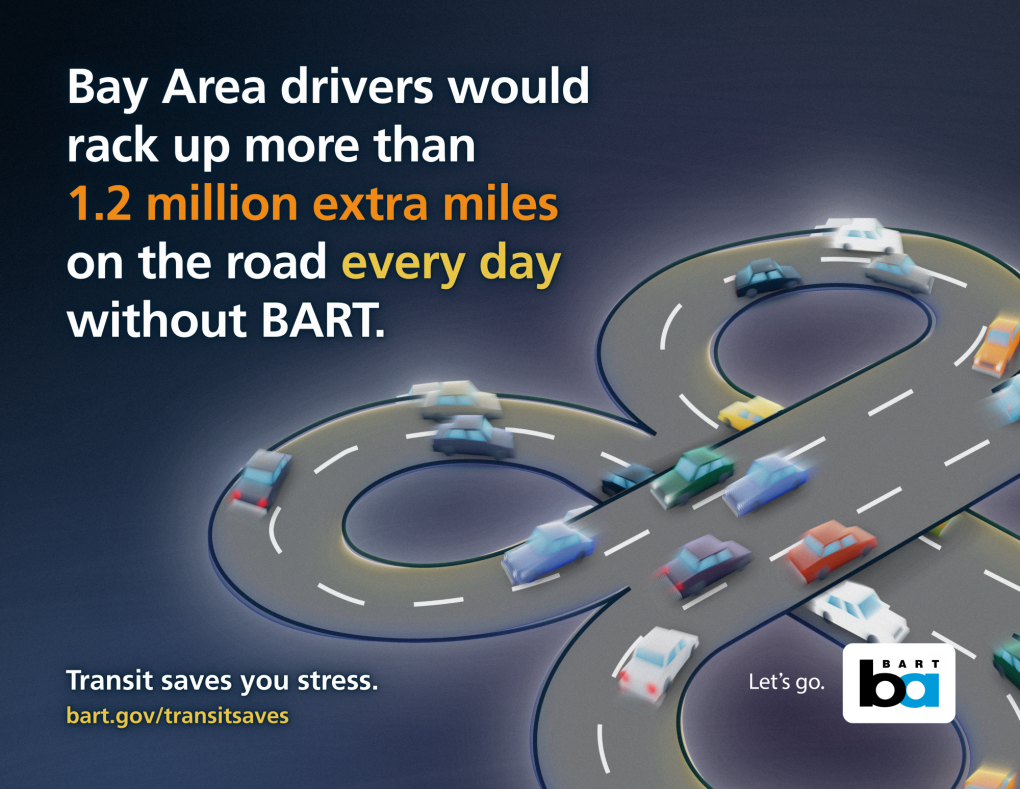Search Results
US Senator Alex Padilla and San Francisco Mayor London Breed tour BART’s Powell Street Station as Transit Ridership Rebounds
On April 12, 2022 U.S Senator Alex Padilla (D.-Calif.) and San Francisco Mayor London Breed joined leaders from BART and San Francisco Municipal Transportation Agency (SFMTA) at Powell Street Station to see firsthand the benefits of American Rescue Plan emergency funds and the potential for upcoming
Join BART's General Manager on a ride-along and happy hour with Transit CEOs on 9/29/23

In celebration of Transit Month 2023, the Bay Area transit agencies and the Metropolitan Transportation Commission (MTC) are hosting a third “All Aboard with Transit CEOs,” a ride-along and social event giving the public a chance to ride with and meet regional transit leaders. The event is also an opportunity for transit leaders to call for on-going financial support for transit operations and to showcase the coordination happening among agencies to improve the rider experience in the Bay Area.
The event is Friday, September 29, 2023, starting at 5pm at the Palo Alto Caltrain Station/Transit Center. The Palo Alto Transit Center is an intermodal transit center served by Caltrain, SamTrans, VTA, Dumbarton Express, the Stanford University Marguerite Shuttle and several local shuttle services.
Trip details:
Before 5pm: The public and Transit CEOs will come from different transit systems, connecting with the public along their route to the Palo Alto Caltrain Station/Transit Center.
5pm: The public and Transit CEOs meet at the Palo Alto Transit Center (Caltrain Northbound Platform to San Francisco) for photos and mingling.
5:19pm – Everyone boards Caltrain #709 for an onboard Happy Hour (BYOB)
5:44pm – Train arrives at Millbrae Transit Center (100 California Drive, Millbrae)
6:03pm – The Ride-a-long ends as the train arrives at San Francisco Caltrain Station (700 4th Street, San Francisco)
Members of the public and the media are invited to ride for the full or partial journey. This event is a great opportunity for the public to chat with CEOs about transit service and transit career opportunities. Follow on social media for real time updates of the CEOs journey.
Participating CEOs include: SamTrans (April Chan), Caltrain (Michelle Bouchard), VTA (Carolyn Gonot), MUNI (Jeff Tumlin), BART (Bob Powers), WETA/SF Bay Ferry (Seamus Murphy), County Connection (Bill Churchill), and LAVTA/Wheels (Christy Wegener).
The CEOs will be taking transit to the Palo Alto Caltrain Station and posting on social media using the #TransitMonth hash tag. Several CEOs will announce their routes to get to Palo Alto Transit Center if you want to join them on the journey.
BART General Manager Bob Powers will take BART's Red Line to Millbrae leaving 19th Street Station at 2:57pm and transfer to Caltrain at 4:02pm
SamTrans CEO April Chan will ride ECR leaving San Carlos Ave / El Camino Street at 4pm
Caltrain Executive Director Michelle Bouchard will ride Caltrain #410 leaving San Carlos Station at 4:48pm
VTA CEO Carolyn Gonot will ride the VTA Blue Line from River Oaks Station leaving at 3:45, changing trains at Baypointe to the 4 pm Orange Line to Mountain View. Then Caltrain #309 departing Mountain View at 4:40 pm
West Oakland
Transit Saves the Planet: BART celebrates Earth Day with educational marketing campaign and collaborative community tree planting
BART's new Transit Saves 2024 campaign art is featured in the slideshow above.
Earth Day is an international event held annually on April 22 to celebrate sustainability and raise awareness about environmental protection. At BART, it is an important opportunity for us to reflect on the many challenges our planet faces, including climate change, deforestation, and environmental pollution, as well as the ways we can be part of the solution.
BART takes special care to acknowledge Earth Day every year because sustainability is a core value of our organization. On past Earth Days, we interviewed riders on trains about their carbon footprints; we created a map highlighting some of the creatures and green features around the BART system; we even put together a BART-themed Earth Day quiz.
This year, we’re celebrating Earth Day with a new educational marketing campaign that highlights some of the environmental benefits of taking BART. The campaign is now live on the digital screens in select stations and will also occupy the ad spaces in stations and trains. You can see the art in the slideshow below.
Additionally, this year BART collaborated with the Oakland Parks and Recreation Foundation and Trees for Oakland to host a tree planting event. The volunteers, which included many BART employees, planted more than 100 native trees at the Martin Luther King Jr. Regional Shoreline in Oakland.
Public transportation is one of the greenest ways to get around, and on Earth Day, BART celebrates that. Learn more about the campaign and the tree planting below.
Happy Earth Day!
BART launches second edition of Transit Saves marketing campaign

A panel from Transit Saves 2023.
Today, BART is thrilled to launch the second edition of our Transit Saves marketing campaign with three novel art concepts. We debuted Transit Saves in 2023 to highlight the many reasons public transportation enhances our communities, but there were simply too many ways “transit saves” to include in a single campaign. So, we created another one.
You can view the new art, which includes updated data from our forthcoming Role in the Region Study, in the above slideshow. As of today, you will begin to see the art around the Bay Area, including in the ad spaces on trains and in stations. Animated versions of the art will be rotating on the digital advertising screens in some BART stations as well.
Check out our Transit Saves webpage for some quick facts about BART’s importance to the region (environmentally and otherwise) and to view our methodology.
BART collaborates with local organizations for tree planting event
BART is committed to bringing the community together to safeguard our local environment.
For Earth Day, BART’s Sustainability Department organized a tree planting event at the Martin Luther King Jr. Regional Shoreline in Oakland on Saturday, April 20, in collaboration with the Oakland Parks and Recreation Foundation and Trees for Oakland. BART employees, their loved ones, BART District 4 Director Robert Raburn and his wife, Pat, and other members of the community came together to plant 100 trees, including Monterey cypress, Catalina ironwood, hollyleaf cherry, flannel bush, and various types of oak. These trees are native, climate adapted and/or shoreline adapted, and will help sequester carbon that would otherwise contribute to climate change. As you can see in the above Transit Saves art, if we didn’t have BART, we’d have to plant a San Francisco-sized forest every 2 years to offset the extra CO2 emissions. The trees we planted will also provide habitat for animal species and shade for humans and animals seeking relief from heat.
“It was such a pleasure to see everyone out here doing work that helps fight against climate change,” said BART’s Principal Sustainability Analyst, Michael Cox. “We are all public servants at BART, and we take extra pride in being able to help our community with events like this.”
Added Alex Pinto, the Community Greening Program Manager at Oakland Parks and Recreation Foundation: “I see Earth Day as an important opportunity for us to connect with nature in new ways and learn about the natural world. Putting away our electronics and placing our hands in the soil can be a relaxing and gratifying experience.”
Please join us this Earth Day by learning about the role transit plays in protecting the Bay Area and our planet. Additional information about BART's ongoing sustainability efforts can be found here. And of course, consider taking BART to your destination whenever possible!
A dream come true for a railroad history museum: The first of 3 legacy BART cars delivered to Western Railway Museum
Friday, August 9, was a thrilling and long-awaited day for the Western Railway Museum (WRM) as the railroad history museum received the first of three decommissioned legacy BART cars for its forthcoming Rapid Transit History Center.
The museum was awarded the three retired cars – an A, B, and C car – following a call for proposals in 2021 that selected eight recipients to receive decommissioned cars (two recipients later declined). BART officially retired its legacy fleet, which carried passengers for more than 50 years since the opening of the system, at a ceremony and final ride in April 2024. All 55 trains in service are now made up of new cars.
BART’s legacy cars have a tremendous sentimental value with passengers in the greater San Francisco Bay Area, and we wanted to ensure the historic vehicles would have a second life, or more accurately, second lives. The chosen six groups will reuse their cars for a multitude of purposes, including a short-term rental in the Sierras, a bike shop and clubhouse for Oakland youth, a dining car with retro arcade games, and more. The Hayward Fire Department picked up their car earlier this year for its new Regional Fire Training Center.
There was one major catch the recipients had to agree to: BART would give the cars to the groups for free, but they had to transport the cars from their temporary home at BART’s Hayward shops to their final destinations.
As you can imagine, moving a 64,000-pound BART car is not something that can be accomplished with your average trailer hitch. It requires a flatbed truck with a yellow “OVERSIZE” banner as well as a crane for getting the car off the bed. Moving just one car costs thousands of dollars.
The Western Railway Museum raised money to make sure they could get the cars to their new temporary home in Car House 3 until their proposed Rapid Transit History Center is completed. The history center will educate the public about BART and its history of innovation. In addition to the three cars, which the public will be able to enter and explore, the center will include displays, videos, a set of wheels from the front of a cab car, third rail equipment, and the antennas that enable the train to pick up power and communicate with train control. In all, the history center will celebrate the "amazing technology of the 'world's first' automated rapid transit system," said Bob Simon, a retired BART Engineering and Operations Manager who sits on the Western Railway Museum's board of directors.
"The creation and implementation of cutting-edge technologies began with BART's visionaires understanding the great challenge to design a new transit concept. They were not unlike the visionaries who went on to build Silicon Valley," he continued, offering his thanks for the support and enthusiasm of BART General Manager Bob Powers, the BART Board of Directors, and the museum's dedicated volunteers and staff.
So what does it take to move a BART car? Western Railway Museum staff found out firsthand on August 9 when they showed up to the Hayward shops with a flatbed truck and helping hands. BART employees prepared for their visit by transferring the car – #1164 – from its holding track (where the soon-to-be-decommissioned legacy cars are held) to the shop bay with a crane.
When the truck arrived from Salazar Heavy Haul – the same company that delivered BART’s Fleet of the Future cars – BART staff hooked the car up to the crane and attempted to load it on the bed. There was an unforeseen problem: The undercar equipment was just a few inches too big for the truck bed, so BART staff had to improvise by removing the battery box and HVAC underneath it. Most decommissioned cars won’t have this problem as they’ll be picked up with the wheels and mounts removed. That wouldn’t do for Western Railway Museum, however.
“They want everything on the cars so they are as authentic as possible,” explained Brian Tsukamoto, BART Manager of Special Projects – Decommissioning. “They’ll be coming back to pick up the battery box and HVAC.”
Once the temporarily modified car was loaded and secured by the highly skilled driver, it was on its way from Hayward to Suisun City up north. A sign in its front window read: “I’m going to the Western Railway Museum.”
At the museum, the team unloaded the car from the truck using a rented crane and used conversion dollies to allow the car, built for BART’s wide gauge, to be maneuvered on their standard-gauge track. Then, using a former Muni work train locomotive, they zig-zagged the car to Car House 3 and unloaded it onto the BART gauge track they built for it. To save on cutting concrete and rebar, a steel rail strap bridge was fabricated to get the car over the car house door foundation and the public walkway to its platform.
The process will soon be repeated with the B and C cars, which the museum is working to schedule with BART staff and Salazar Heavy Haul. We’ll be sharing updates.
Learn more about the Western History Museum here and the Legacy Fleet Decommissioning project here.
Position open on BART Police Citizen Review Board – District 5 (Accepting applications until 08/08/24)
BART will be accepting applications for membership on the BART Police Citizen Review Board (BPCRB) from Monday, July 8, 2024 - Thursday, August 8, 2024. This appointment will be made by BART Director Melissa Hernandez, District 5.
As a volunteer of the BPCRB, members work to increase the public's confidence in BART's policing services by:
- Reviewing, recommending, and monitoring the implementation of changes to police policies, procedures, and practices
- Receiving citizen allegations of on-duty police misconduct
- Advising Board of Directors, General Manager, Independent Police Auditor, and Police Chief
- Participating in recommending appropriate disciplinary action
- Meeting periodically with representatives of the BART Police associations
- Participating in community outreach
Member Qualifications
Members must:
- Reside within Alameda, Contra Costa, San Francisco, or San Mateo counties
- Be fair-minded and objective
- Have demonstrated commitment to community service
- Not be currently employed in a law enforcement capacity, either sworn or non-sworn
- Not be a relative of current or former BART Police Department personnel
- Have no felony convictions
Duration of Service
All appointments to the BPCRB are for a term of two years. There are no term limits.
How to Apply
To learn more about the BPCRB and/or how to apply for appointment, visit our website at bart.gov/about/bod/advisory/crb. Access the digital application here and the print application below.
Please send an email to [email protected] or call (510) 464-6083 with any questions.
Application period closes on Thursday, August 8, 2024
Documents
BPCRB Recruitment Flyer (.doc)
Application for BPCRB - District 5 (.doc)
BPCRB General Information (.doc)
BART PD hosts National Night Out Tuesday August 6th at Bay Fair and Millbrae stations
BART Police is participating in National Night Out, a community-building event held on the first Tuesday in August every year. This year, BART Police will host two events, and BART employees and their families are invited to join in. The events will be held at Bay Fair and Millbrae stations and will feature games, music, food, and opportunities to interact with BART Police officers and staff.
First introduced in 1984, National Night Out aims to enhance the relationship between neighbors and law enforcement. BART Police has participated in the campaign for over a decade.
Both events are from 4-7pm on Tuesday, August 6.
Bay Fair Station
15242 Hesperian Blvd, San Leandro
Hosted by Community Service Officer Susie Johnston
Millbrae Station
200 North Rollins Rd, Millbrae
Hosted by Crisis Intervention Specialist Remberto Calero
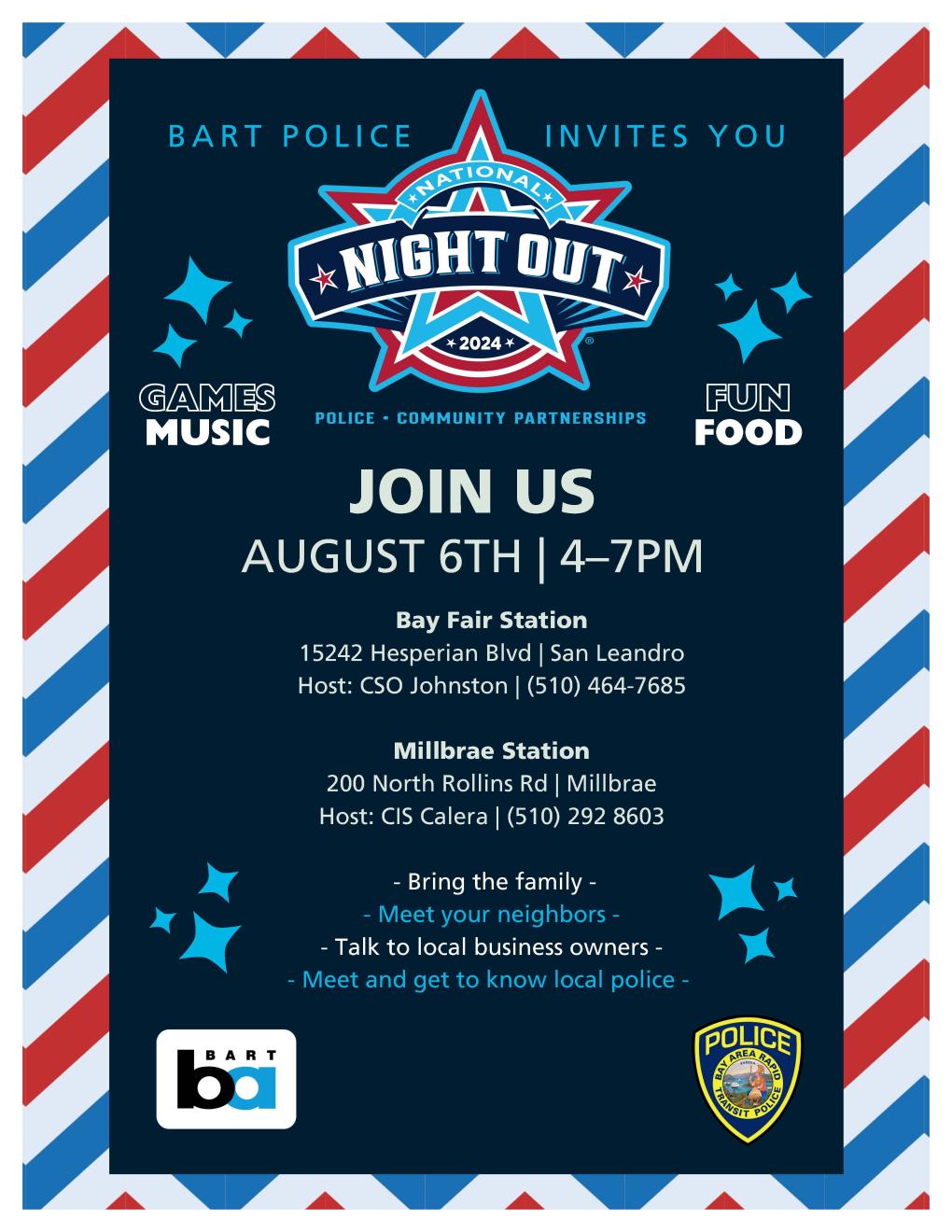
BART invites the public to “ride into history” at a legacy car retirement ceremony and final ride on 4/20/24
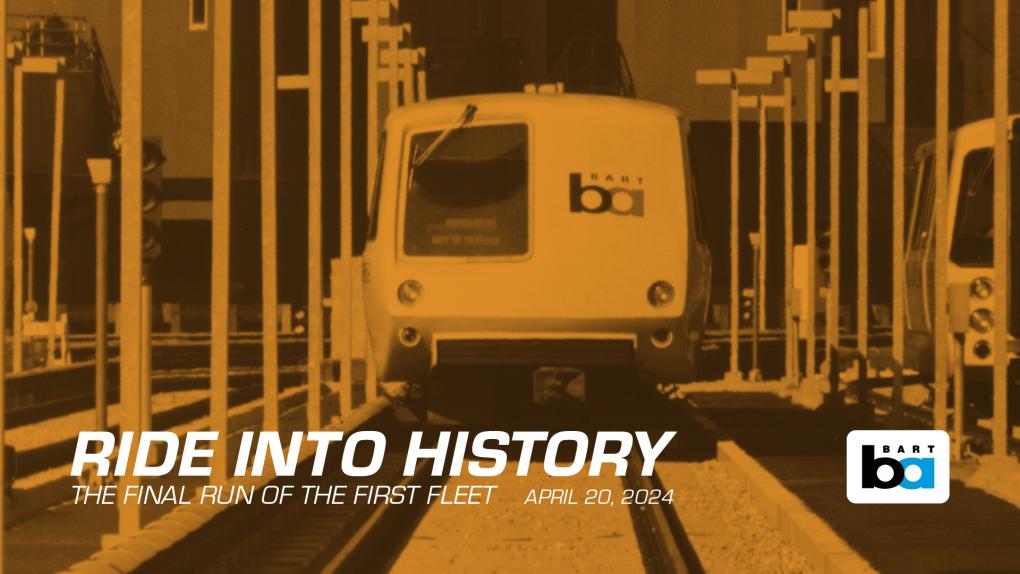
BART invites the public to join us to mark and celebrate the end of an era: the last run of BART’s legacy trains composed of rail cars that have been serving the Bay Area for more than half a century. We’re calling the event “Riding into History: Final Run of the First Fleet.”
The retirement ceremony will begin at 1pm on Saturday, April 20, 2024 at Oakland’s MacArthur Station with the and final dispatch of legacy trains happening after the speeches.
We recommend arriving around noon to enjoy the food trucks and activities we have planned.
The ceremony will take place in the plaza (free area) of the MacArthur station and will include food trucks (bayareamunchiez.com and noodle-cone.com), activity tables, a raffle for legacy car number plates, a pop-up merch store, and a stamp rally. Bring your stamp rally passport if you have one. Many of the groups who are repurposing old BART cars for new uses will be in attendance to share information about their projects.
Following the ceremony, the public will line up in the plaza and then board a legacy train and ride from MacArthur to Fremont Station, mirroring the initial service BART provided when it opened September 11, 1972. It’s a 45-minute trip that travels along approximately 24 miles of the original section of tracks. There will be more than one legacy train for the event. The trains will make all station stops and may turn around at Bay Fair depending on the number of attendees waiting to ride.
Every rider will need to pay for the ride with their Clipper card. The fare depends on where each rider is going after the ride.
“These train cars are part of the history of the Bay Area,” said Bob Powers, BART General Manager. “While we are excited to modernize the system, we recognize the profound cultural importance of these cars, and we want to celebrate their rich history and give them a proper send off.”
BART is able to completely retire the legacy fleet thanks to the success of the Fleet of the Future project. Seven hundred six new Fleet of the Future train cars are now certified for service – that’s 30 more cars than the legacy fleet inventory. A total of 720 new cars are on BART property as of April 1, 2024, and twenty cars a month are now being delivered to BART – twice as many as when the new cars first began to be delivered to the Hayward test track in 2016.
While the April 20 trip will be the final time the public will be able to ride the legacy fleet cars, it won’t be the last opportunity to spend time with the historic vehicles.
Three legacy cars will be headed to the Western Railway Museum in Suisun City for preservation and to provide a space for transit enthusiasts, researchers, and museum guests to enjoy and study for years to come. The three cars, including an iconic sloped-front A car, will be the only cars from the legacy fleet to be displayed at a museum.
A handful of other legacy cars will be transferred to those who successfully submitted proposals to repurpose the cars for short-term rentals, entertainment venues, and training facilities.
Most of the legacy cars, however, have been recycled, so April 20 is the last chance to ride these historic cars.
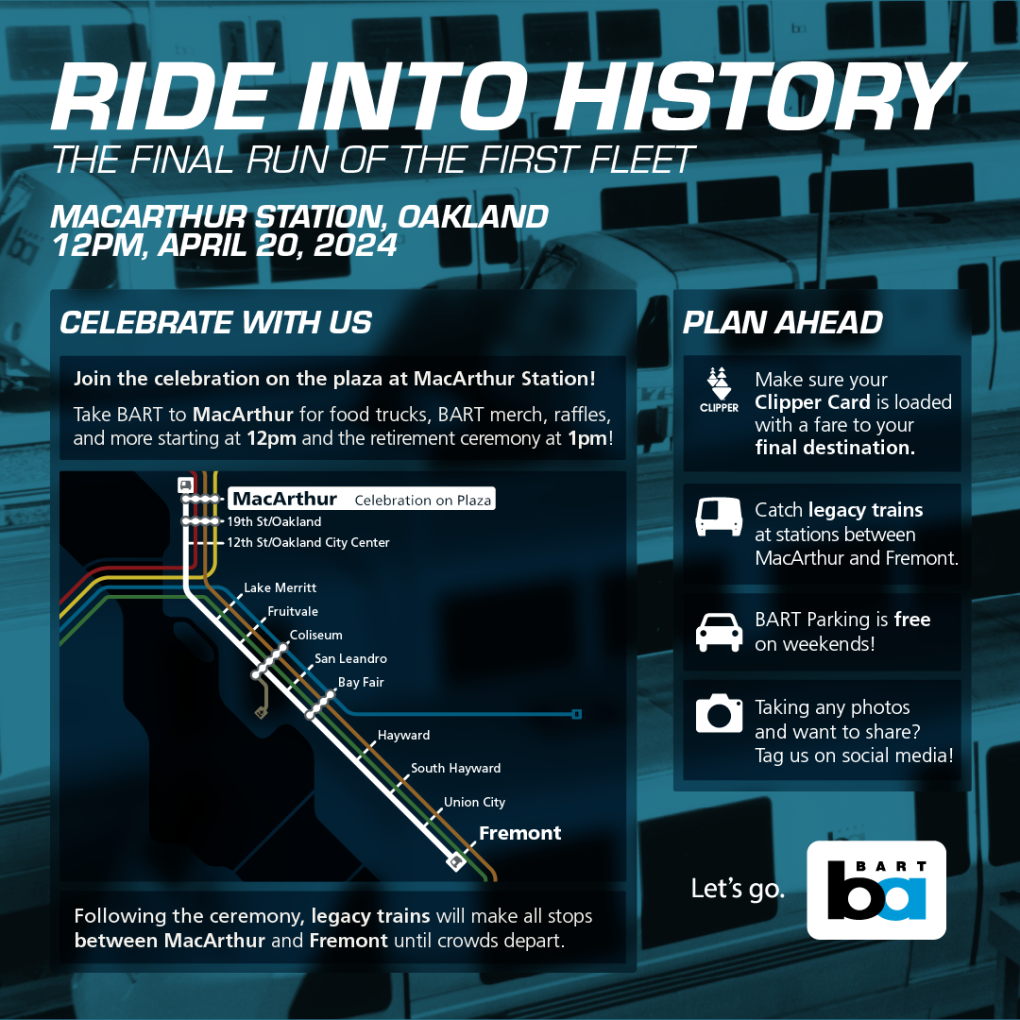
BART offers special early service with limited stops for first ever visit by ESPN’s College GameDay to Cal
BART is launching an early morning service blitz to help Cal fans get to the first ever appearance of ESPN’s College GameDay pregame show in Berkeley this Saturday, October 5. BART will offer five trains with limited stops before our regular Saturday service begins at 6am. The special early service will get fans to Downtown Berkeley Station around 5am, before the start of the pregame show.
The special early morning event trains will only serve the following stations: Daly City, 16th Street Mission, Powell, Pleasant Hill, Walnut Creek, Orinda, Fremont, Dublin/Pleasanton, Bay Fair, Fruitvale, El Cerrito del Norte, and MacArthur. These 12 stations in addition to Downtown Berkeley will be the only ones opened for the special early service. Full details on our added early morning service are available in the Trip Planner at BART.gov and on the official BART app.
The added early morning trains will go out of service once they complete their trips. Riders cannot board a train at Downtown Berkeley before regular Saturday service begins at 6am.
The game against Miami kicks off at 7:30pm. BART will run longer 8-car trains on the Red and Orange lines as well as add several event trains to its normal service that night to accommodate the anticipated crowds.
Special Service Details
*A northbound Red Line train will leave Daly City at 4:19am and will make stops at 16th Street Mission, Powell, and MacArthur before arriving at Downtown Berkeley Station at 4:55am.
*A southbound Orange Line train will leave El Cerrito del Norte at 4:47am and arrive at Downtown Berkeley Station at 4:55am.
*A northbound Orange Line train will leave Fremont at 4:13am and will make stops at Bay Fair, Fruitvale, and MacArthur before arriving at Downtown Berkeley at 4:55am.
*A westbound Blue Line train will depart Dublin/Pleasanton at 4:08am and stop at Bay Fair at 4:25am where riders can then transfer to the northbound Orange Line train to Downtown Berkeley at 4:25am.
*A southbound Yellow Line train will depart Pleasant Hill at 4:25am and make stops at Walnut Creek and Orinda before arriving at MacArthur Station at 4:45am where riders can transfer to the northbound Orange Line train to Downtown Berkeley at 4:50am.
Tips
BART parking is free on Saturdays. People driving to BART to take the early trains should park at one of the stations being served. There is no BART parking available at 16th Street Mission and Powell stations.
Once on the platform, the added trains will be labelled as: “Limited Stops to Downtown Berkeley.”
Load your Clipper card in advance with enough funds for the round trip.
If you don’t have a Clipper card, add one for free ($3 savings) to your phone’s wallet in advance and use Google Pay or Apple Pay.
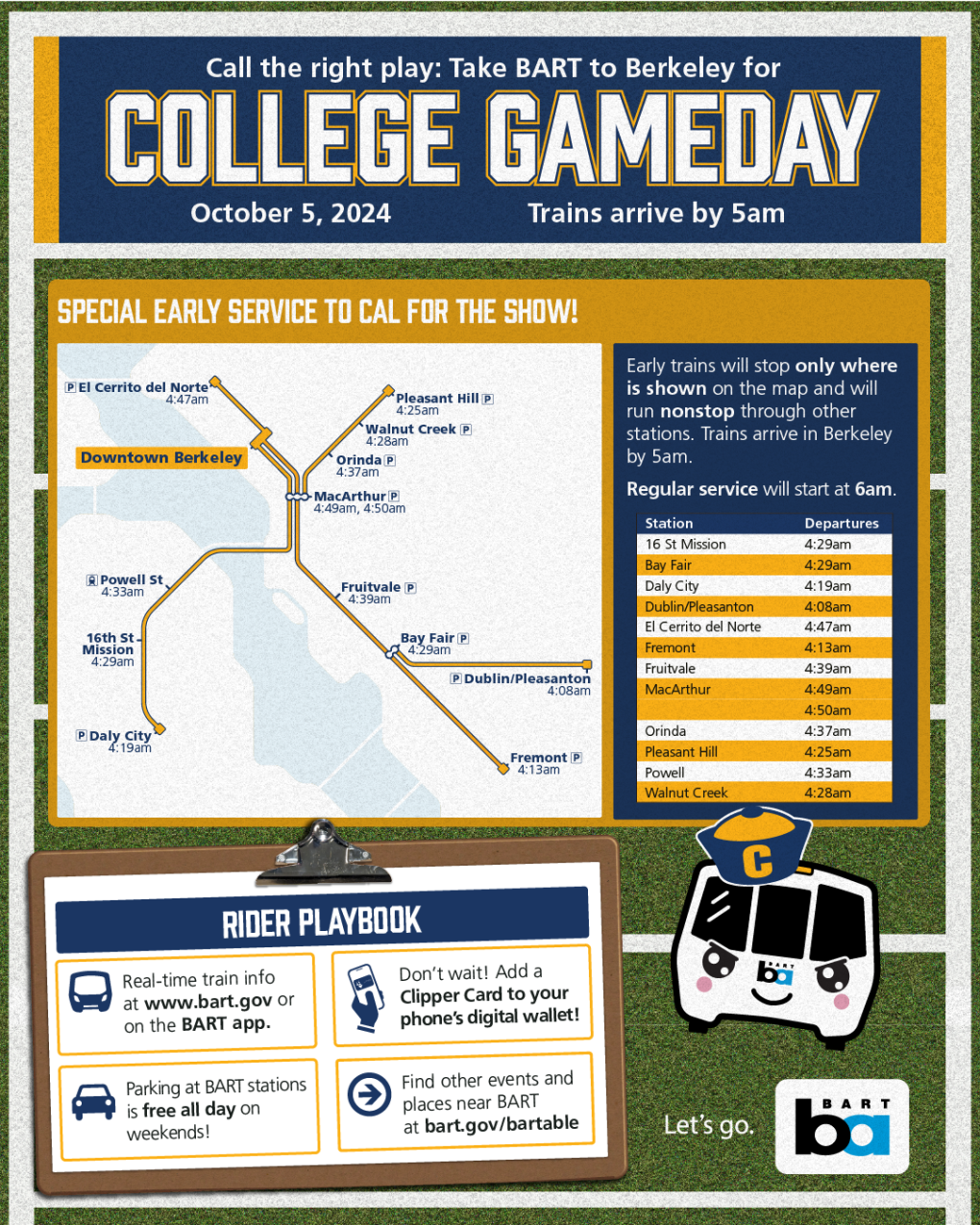
BART App to undergo planned maintenance on July 19, 2024 impacting some features including parking payment
On the evening of Friday, July 19, 2024, BART will perform planned maintenance on the official BART app starting at around 3pm and lasting several hours. During the maintenance, the BART Trip Planner, real time train departures, service alerts, and the fare calculator will continue to be available on the app. Parking payment features will not be available however parking is free after 3pm and on weekends and the maintenance will be complete in time for weekday riders. For those looking to reserve parking in advance during the maintenance window, they will get a prompt to try again on Saturday when the maintenance is complete. BART’s website for purchasing reserving parking will also be impacted during the same timeframe.
The profile and account setting features will also not be available on the app beginning at around 3pm on July 19, 2024, and lasting several hours.
Following the maintenance, app users will be prompted to update to the latest version of the app.
